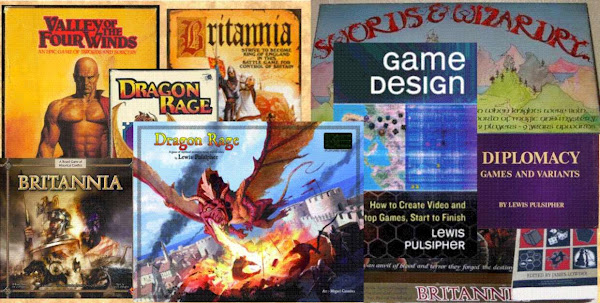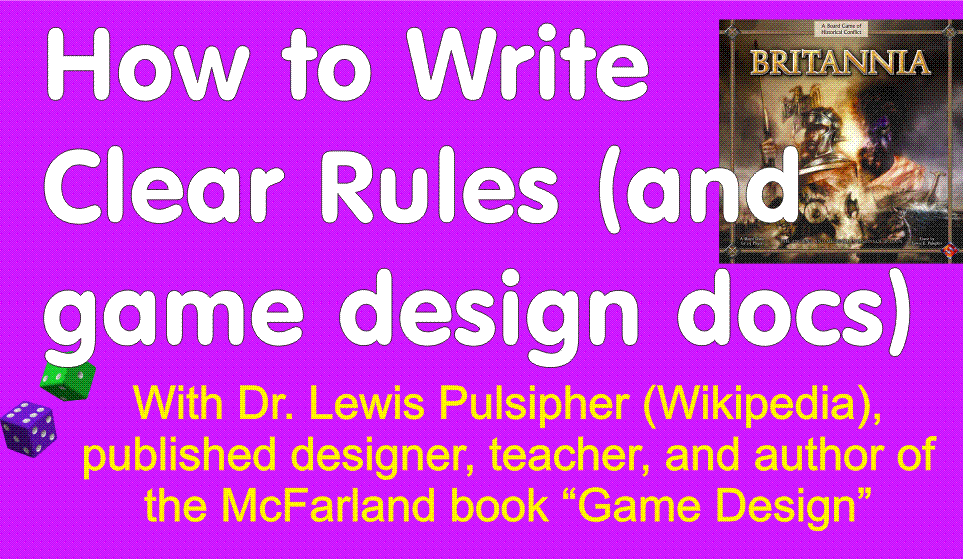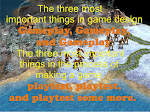Compendium of Britannia-like Games, Published and Unpublished
A
listing and description
This is edited and revised from
the transcript of a video. I offer free videos on the “Game Design” channel on
YouTube: http://www.youtube.com/user/LewGameDesign
There aren’t many games that
have spawned a group of games using similar systems by different designers, but my game Britannia is one. I haven't even laid hands on some of these games.
I've only played Britannia, Duel Britannia, and (once) Italia.
I include both published and
unpublished games, the ones that I've been able to find. The objective here is
to talk briefly about each one.
Maybe I should characterize Britannia first. Britannia is about migrations and organized invasions in the Dark
and Mediaeval ages, using a large area map of Britain. It covers a very long
time scale, about a thousand years. It equates population with armies, which is
a Dark Age characteristic. It has an economy, that is, you don't just have
units appearing at given times and places, though that also happens. You can
build/raise more units, according to your economy, which depends on what lands
you occupy, using the old mantra that Land Equals Wealth.
Point scoring is by nation and a
player controls several nations (usually four) during the course of the game.
The player’s nations cannot cooperatively attack or defend their separate
nations; if they happen to be in the same place they have to fight. There are
no event cards, and the game uses dice combat. There are about 200 armies with
no numbers on them, just an identifier. Four players is the norm, three is
sometimes a variation.
Many of the following games
deviate in one or more ways from this summary, even some of my games from this
list. So we have many games of similar complexity. There are also games that
are more complex and there are a few published games that are less complex -
well, actually just one that's been published so far.
I'm not listing the designers
because I may not know or may not remember. Since I moved house I don't know
where many of these games are in my house. Sorry about that, but most of them
are on boardgamegeek, the published ones anyway.
The first here is Ancient Conquest I and II. I list these
first because Ancient Conquest I
predates Britannia. I saw that game
being played, and read the rules, somewhere, sometime in the 70s, probably the
late 70s. I borrowed the notion of several nations per player, but I don't let
those nations cooperate. In Ancient
Conquest, the player moves all his/her nations at once, and they can
cooperate closely, even occupying the same city.
Ancient Conquest is a hex and counter wargame with numbers on the
counters. The map has a hexagonal grid. It uses a combat table. As far as I can
recall it only had an order of battle, not an economy. In other words, you got
pieces when you got them and that was it. What you did on the board didn't make
any difference generally to how many pieces you could acquire, making it, in my
taxonomy, a Battle game rather than a War game.
Ancient Conquest I and II share similar maps. They depict the early
and later history of the ancient Near/Middle East/Eastern Europe, so it
includes Greece for example.
Maharajah is the first game that followed Britannia. This was done by Avalon Hill some years after they
published Britannia. It's a slavish
imitation in some ways, for example, the identical number of nations and the
same number of land areas as Britannia.
It has the problem of Indian history, that all the invasions come from the
northwest instead of from all around. One of the great advantages of Britannia is the invasions come from all
around. Now if you get into gunpowder days and the Europeans then you've got
invasions from the sea, but I think that's a big mistake. Nonetheless, it was done
here, so late in the game you have the Europeans. I've read that the designer
died during the process and maybe that had some affect on it. People say it's a
good three player game but not a good four player game
Chariot Lords is the ancient Near and Middle East. There is no
economy, you get back a portion of your dead. It has random player turn order,
you roll for the player order every turn, and that's horrible to me, it just
makes a hash out of the whole business, but that's a matter of preference.
Moreover it has possibly the most confused and unclear set of rules I have ever
read.
Peninsula Italica (1993), is ancient Italy from 2000 to 200 BC. All
I know is what I read on Boardgamegeek. That Sicily is four areas gives an idea
of the scale. About 250 cardboard pieces. Evidently Italian language rules
only.
The Dragon and the Pearl covers pre-gunpowder Chinese history. It
was published by a United Kingdom game shop with a plasticized map, plastic
disc pieces with stickers, coming in a cardboard tube. It's a pretty
straightforward adaptation of the Britannia
game system. While I’ve not played, I wouldn't be surprised if this is the
best of the Brit-like games other than Britannia
itself.
Hispania is the history of the Iberian Peninsula. The problem here
is that at times the entire area was ruled by one government, for decades or
centuries. The Romans, the Visigoths, the Muslims except for Asturias, which
didn't amount to much at that point, all controlled the peninsula. How does a
game cope with this? This game is much more complex than Britannia. It has something like 500 pieces and several additional
piece types, using 10 sided dice to help differentiate the types.
Rus is a game of Russia in early days, self published long before
Kickstarter. I've read some criticism of how it plays, I haven't tried it
myself. It's a difficult subject, not one that I've even tried, and I try a
lot. There's so much difference between the steppe and the forest areas of Russia. The area of the board
extends well beyond Russia, not surprisingly. The name is a reference to the
Vikings who came to Russia and established the early principalities.
Hegemonia (2004) is about ancient Greece and Western Persia, and
some of Italy. I've never seen the game, only images of the map and rules (in
German). It was offered privately in Germany in a limited form, could be print
and play, I don't know. In fact I'm not sure I know anybody who's ever seen it,
let alone played it.
China: the Middle Kingdom. This is Chinese history from ancient
times, extending through the Chinese Civil War post-World War II, and my view
is the Britannia system doesn't model
the gunpowder era, let alone World War II; the system was made for gradual
migrations, slow movement and communication, with a population that was more or
less synonymous with the army, none of which is true in gunpowder times.
The game also suffers from what
I can only call an egregious error. The playable board doesn't extend beyond
China's modern boundaries. So
Mongolia, for example, is not part of the playable board. Korea is not
playable. Vietnam is not playable. Those are areas that at times the Chinese
dominated or actually controlled, but you can't play there. Think about that.
Why would you do that?
It introduces an idea with
rebellions where in order for one dynasty to be followed by another you roll a
lot of dice for individual areas to determine whether they go over to the new
dynasty. It's also interesting in that the attackers have a permanent advantage over the defenders:
attackers hit on a 4, 5 or 6, defenders on a 5 or 6.
Italia is by the same designer as Hispania. It's also similarly complex. It covers Italy, a bit of
North Africa, and some of the border land around northern Italy. The game uses
a “campaigns” rule involving big groups of units making repeated attacks as
they move through areas, so that a campaign can conquer a large area at once.
This is sort of a super-major invasion.
Given Italian history, there are
two game segments separated by the period of Roman domination and the Empire.
One of the main scenarios is for three players rather than four.
Invasions I and II are
all of Europe and North Africa post Rome. Invasions
I covers earlier history and the second will cover later history. There are
vastly more areas than Britannia. I
counted once (from images, have not seen the game itself), and it seems like
there were around 150, and vastly more pieces and piece types than Brit. So
it's in the vein of Hispania and Italia, but even bigger. It's also one
of the few (only?) Britannia-like
games that uses event cards. The designer is also designer of Europa Universalis I in both the
tabletop and video versions, which may help explain the level of complexity.
Other than Duel Britannia, this is
the most recently published Brit-like game I know of.
Finally we have Duel Britannia. This is packaged with
the 2020 reissue of Britannia, two
games in one box. It's for two players,
up to 90 minutes, seven turns, many fewer land areas on a new board, so it's
considerably simpler than Britannia,
especially in the immensely simpler scoring. It is a two player game, although
perhaps someone will make a three player game out of it someday. But that
three-player is not in the box because I only had a year to design it, and the
two player was a pain in the butt to try to get balanced, so I didn't get to
the three player game.
This and the reissue of Britannia are the only Britannia-like games using plastic
figure armies. They’re 18 mm tall, which is much larger, for example, than the
soldier pieces in Risk, and I've seen
photos of the figures as painted by gamers - painted individually and in detail.
Then we have “B3" as I call
it, the third edition of Britannia,
which actually is three separate games: Epic
Britannia, Rule Britannia, and Conquer
Britannia.
Epic is what I call a better
teaching tool, some may suggest “more realistic”. It has more constraints on
the players, otherwise a full Britannia. There’s also a free-form mode that
works well with two through five players, and is much quicker and simpler than
older Brit. The scoring of the free-form uses the simple method that I've used
in some of the small games (such as Duel
Brit).
Armies cannot vacate areas (as
in Risk). There are land raids or
forays. Armies are not allowed to make suicide attacks when faced with
starvation, instead their entire group must attack. The Romans have to work at
it to succeed, which they don't really in second edition Britannia. This had lots of solo testing but not much by others,
but it has “lain fallow” for years.
Rule Britannia is nine turns, four players, diceless. It uses
combat cards, and includes Ireland. It's been tested a little by others a long
time ago. The diceless method has been tested a lot in other games.
Much of Duel Britannia methods derive from Conquer Britannia. Conquer Britannia is an up to 120 minute game
for four players, the shortest play so far is 84 minutes. It begins after the
Roman withdrawal, just as Duel Brit
does. It's been playtested by others a lot. I intend to make a three player
version for before the Romans appear. It has six turns, 18 land areas, 11
nations.
I've designed quite a few other
games to various stages. “Mega Brit” had 55 land areas, 24 nations, 24 turns,
and included Ireland. I played this, maybe three times solo a long time ago.
Dark Ages Europe, from about 400 CE to 1250, is for five players
quite big, played once by others, some by me. A different, huge Europe game
that didn't have a name was played once by several people in 1980. 12 hours,
and I had a note on it that if Britannia got published, maybe this could be
published. But now it's long abandoned.
Then we have for three or four
players, Adventus Saxonum or Arthuria, including only England and
Wales with 20 nations. It starts when the Romans are gone and ends before the
Vikings.
Caledonia is the early history of Scotland. It's simpler and
shorter than Britannia.
Normannia is Britain, France, and the Vikings only.
Barbaria is all of Europe 400CE to 1250 in six turns. It is simpler
and much shorter than Britannia, and
unlike most of these it has been submitted to publishers (unsuccessful so far).
Frankia: the early history of France and Germany is diceless and
uses the card combat system. It has three scenarios, one for three players, the
others for four. This has been submitted, not yet accepted anywhere.
Hellenia is not complex, but it's a large map because it's all the Mediterranean, and the Near East, so
you have a very long but fairly narrow map. Rome, Carthage, and the Diadochi,
five players, I think.
Hibernia is more like a block game, but it has many Britannia-like characteristics. It's the
early history of Ireland for three players,
not four.
The most recent one, Minimalist Britannia as I call it so
far, has only 13 land areas, three players, diceless, and it plays solo in an
hour. Whether I can balance it, who knows? Fortunately, three player games can
be self-balancing.
I started on a all-of-Third Age
J.R.R. Tolkien game, which I’ve played once. But a license is expensive. Also,
I have since realized it should be a co-op game as well (competitive version
and co-op version).
This list excludes games I have
mapped out or set up reinforcement schedules for but haven't played: India,
Iberia, Graecia, Central Asia, China, Babylonia, the Balkans, Wales, Columbia
(the Americas), Byzantium, Sicily even. Who knows where else that I've
forgotten over the years - most of these were a long time ago. It is of course
a drawback of Britannia-like games
that they tend to be long and that's not what people want these days.
Unpublished by Other Designers
Now for unpublished games by
other designers. There was one called Mandate
of Heaven (China) that I ran across in an online playtest years ago, and I
haven't heard of it since. It was huge.
There's one called Corsica, about a relatively small island
in the Mediterranean southeast of France. It's where Napoleon Bonaparte grew
up. I have a print n play copy, and there may be an electronic form ultimately.
It is as big as Britannia despite the
smallness of the island.
An unpublished game called Conquest of Europe by Roger Heywood, who
was the uncredited developer of the original Britannia for HP Gibsons, has an entry in boardgamegeek.
There may be more but the
unpublished ones are hard to ferret out.
Not Brit-like
You may have heard of my game Germania (nearly published twice) and might have thought from the title
that it's Britannia-like. It is not,
although it is of similar scale.
Then we have History of the World, which is a “sweep
of history” game but not Britannia-like,
though I have to say, it might benefit from being more like Britannia. It certainly loses sight of
history.
This turned out to be a lot more
than I expected, and now I should get some more of mine published.











.jpg)
.jpg)